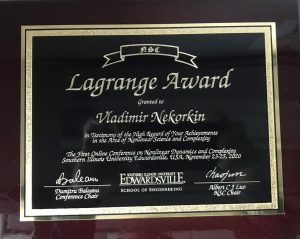Vladimir Nekorkin

Statement of achievements
- Professor Vladimir Nekorkin has developed the model of the olivo-cerebellar network. The olivo-cerebellar network is a key neuronal circuit that provides high-level motor control in the vertebrate CNS. Based on the neuronal connectivity and electrophysiology of the olivo-cerebellar network he has developed a general-purpose control approach capable of dealing with a large number of actuator parameters in real time (Neural Networks, v. 17, 2004; Proc. Natl. Acad. Sci. USA, v. 100, №22, 2003; Proc. Natl. Acad. Sci. USA, v. 101, №52, 2004; Radiophysics and Quantum Electronics, v. 55, №3, 2012; US Patent №7822694, 26.10.2010; US Patent №7870086, 10.06.2011).
- In stochastic neural model FitzHugh-Nagumo when operating slightly beyond the supercritical Andronov-Hopf bifurcation (in the “canard” region) new firing activity (spiking) was discovered. These spikes emerge owing to a stochastic transitions between the low amplitude subthreshold oscillations and large-amplitude excursions in the phase plane. He also provided the conditions for imperfect phase locking between interspike intervals and subthreshold oscillations (PRL, v. 86, №15, 2001).
- An infinite set of travelling waves are found in a discrete analog of the nonlinear diffusion Huxley equation. Their profiles are determined by the trajectories of Bernoulli scheme containing two symbols. It is proved that these waves are stable with respect to perturbations moving with the same speed, that is chaos of travelling waves is realized in this system (Int. J. Bifurcation and Chaos, v.4, №3, 1994).
- A new phenomenon of the chimera states cloning in a large two-layer multiplex network with short-term couplings has been discovered and studied. For certain values of strength and time of multiplex interaction, in the initially disordered layer, a state of chimera is formed with the same characteristics (the same average frequency and amplitude distributions in coherent and incoherent parts, as well as an identical phase distribution in coherent part), as in the chimera which was set in the other layer. The mechanism of the chimera states cloning is examined. It is shown that the cloning is not related with synchronization, but arises from the competition of oscillations in pairs of oscillators from different layers (JETP Letters , v. 108, № 8, 2018; Front. Appl. Math. Stat., V. 5, 2019).
- The first example of irreversible dynamical system demonstrating a new (third) type of deterministic chaos, which is characterized by fundamental inseparability of attractors, repellers, and elements of conservative dynamics, is given. In the phase space, the image of this behavior is a new type of attractor – the so-called reversible core. The core is formed by intersection of a chaotic attractor and a repeller. All the time the trajectories stay in the neighborhood of such an attractor, which is also a chaotic repeller, thus forming the so-called mixed dynamics (Chaos, v. 29, № 11, 2019; Chaos, v. 30, № 5, 2020).
